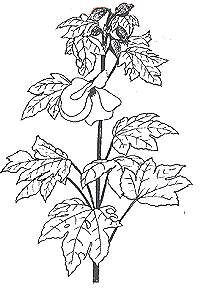Bele (Hibiscus manihot) - which is also known as slippery cabbage, aibika and sunset hibiscus - is a plant whose leaves are often used in cooking in the South Pacific. Recently it has spread throughout the Pacific and its popularity and many uses could mean it may be useful in other countries.
Bele can be recognized by its dark shiny leaves and beautiful yellow flowers. It grows 1-1½m high.
What makes it so popular? One of the reasons may be that it is so easy to grow. It is propagated by cuttings which are 15 to 30 cm long. The new plant is ready to harvest just 2-3 months after planting. A healthy plant will produce for 1-2 years. The leaves vary in size and shape, depending on the variety. They are very tasty to eat, apart from a slightly slippery texture which some people do not like. Nutritionally they are very rich.
Its high nutritional value may also be responsible for its popularity. The protein content of the leaves is very high - 5%. It also contains high levels of vitamin A, vitamin C and calcium, as well as significant amounts of iron. So it will make a valuable addition to any diet. The World Health Organisation recommends it as a good first vegetable for babies. This is, because the young shoots and leaves contain very little fibre, so it is easy to digest. There are also records from Papua New Guinea which show that bele medicines are used for rashes, constipation, colds and sore throats and childbirth fertility medicines.
The areas where bele is found are tropical or sub-tropical. It is ideal as a vegetable for home gardens in these areas since it needs very little care - though it does better with some manure and weeding. It produces a high yield - 0.36 tons/hectare/year. It is susceptible to insect damage, but in the home garden, this can be easily overcome by picking the insects off by hand.
A popular recipe for bele is to wrap pieces of fish in bele leaves and cook in coconut cream. Another is to mix bele with mackerel and onions and lightly fry. Almost any vegetable recipe can be adapted to include bele - and it can even be eaten raw in salads.
Are there varieties of this useful plant in your area? Ask your extension officer for advice about how you could obtain cuttings.
If you have problems, try writing to... Laloki Research Station, PO Box 417, Konedobu, Papua New Guinea.
Nicky Davison sent in this article from Pohnpei, Micronesia where she is encouraging gardening for improved nutrition.









